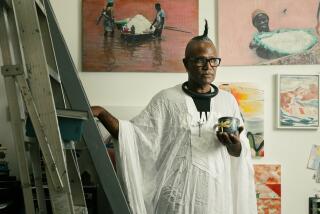Professor Creates Art That’s Both Recycled, Original
She didn’t mince words when asked Thursday to describe David Sloan’s artwork.
“It’s trash,” said Ayca Cakmakli, a 20-year-old Whittier College student.
She’s right. Sloan, an art professor, uses empty cereal and cake mix boxes and frozen-food packages to create colorful wall hangings that help satisfy the small campus’ appetite for fine art.
“I certainly think it’s fine art,” Sloan said. “This may be garbage, but I’m doing something creditably within the world of fine arts.”
Staff members and the school’s 1,300 students contribute the artist’s supplies.
“I can tell who’s dieting around here and who’s not,” said Sloan, 47. “Fortunately for me, my contributors aren’t too hung up on dieting.”
Sloan stumbled onto his art form three years ago after salvaging some classroom windows from Deihl Hall, the college’s modern languages building. The 75-year-old wooden sashes were being replaced with aluminum window frames.
He decided to use the old windows as art frames. But what would they enclose?
One day Sloan noticed the repetitive pattern of the colorful packaging on a stack of supermarket cereal boxes. The look reminded him of work done by Tony Cragg, a British artist whom Sloan admires.
Sloan rummaged through the trash at his Brea home and began experimenting with empty food packages. “I’m a big consumer of packaged goods,” he acknowledged. “I do little food preparation from scratch.”
He tried soaking the discarded cardboard and then mushing it into pulp that could squeezed into a mold. That didn’t work.
Then he tried folding the wet cardboard into long strips. To his delight, he discovered they held their shape when allowed to dry while being compressed. When the strips were arranged in rows and layers, they created intriguing shapes and colors.
Sloan devised an inch-wide, three-foot-deep plywood form that allowed him to quickly squeeze wet food boxes into accordion-like strips. Soon, he was mass-producing them.
The strips are weighted down with concrete blocks when they are removed from the form and placed on a table to dry. Then each row of strips is glued to plywood backing before being placed in a window frame. A coating of roofing tar applied to the surface of the window frame completes the artwork.
Hundreds of empty food boxes are required for each of Sloan’s pieces, which he assembles in a workspace beneath the wooden bleachers in the college’s former gymnasium--a 1925 structure that now houses the school’s art department. That means he has to make frequent campus appeals for more empty food packages.
No wonder a large crowd of curious students and staff members turned out when Sloan’s artwork made its debut last month at the Brewery, an artists colony and collection of galleries in Los Angeles.
“It was like looking through a window into someone’s life,” said Paul Kjellberg, a Whittier College philosophy professor who lives in Hacienda Heights and viewed Sloan’s work at the show.
“It was meticulously done. All of us could see some of our own garbage reflected in the art. I was responsible for a lot of the six-packs in there,” he joked.
Sloan, when pressed, offers a scholarly appraisal of the empty-package art. “Materials, organization and metaphor converge in my work.... I deliberately avoid self-conscious adherence to guiding principles and influences, except, perhaps, a precious few notions, specifically the recognition that pattern can be powerful and that waste is to be avoided.”
In other words, trash is turned into treasure.
Sloan has not put any of his food-box works on sale. When he does, he laughs, “I won’t settle for anything less than the minimum wage: $5.75 an hour. And these things are really time-intensive. They take about 150 hours per piece.”
Cakmakli, a junior international relations student, hinted that she might someday be in the market for Sloan’s art as she picked out packaging that once held Lean Cuisine, Diet Coke, Quaker Oats Toasty Oatmeal Squares and other popular food brands.
It would go nicely, she said, “maybe in my dining room.”
More to Read
The biggest entertainment stories
Get our big stories about Hollywood, film, television, music, arts, culture and more right in your inbox as soon as they publish.
You may occasionally receive promotional content from the Los Angeles Times.











